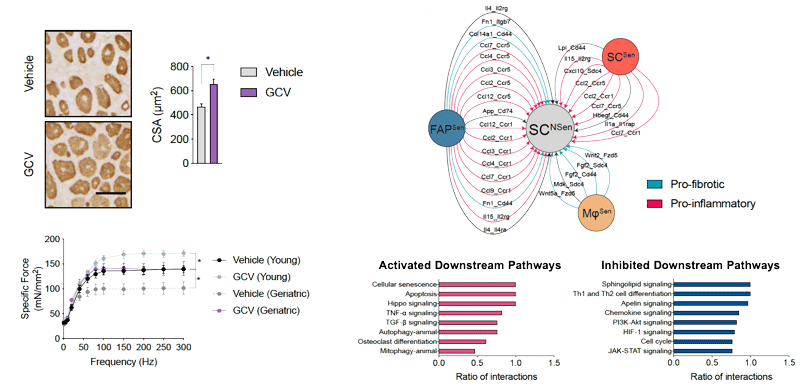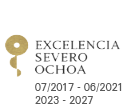
2022/12/21
How damaged cells inhibit muscle regeneration over lifetime
Humans have a limited capacity for self-regeneration of tissues and organs but they do keep a pool of stem cells throughout their life that can self-renew and differentiate into specific cell types. These stem cells are widely studied as they could enable the repair of human tissues and thus have great potential for medicine. On the other hand, all human cells can enter a state called senescence: they stop multiplying but don’t die, lingering within the tissue. As these senescent cells accumulate throughout the body, they can impact nearby healthy cells. An international team of researchers, including Prof. Antonio Del Sol leader of Computational Biology at CIC bioGUNE and the Luxembourg Centre for Systems Biomedicine (LCSB) of the University of Luxembourg, recently explored the role of senescent cells in tissue regeneration. They uncovered key interactions between senescent cells and stem cells, opening potential avenues towards improving muscle repair throughout life. Their findings are published in Nature in December.
Stem cells, senescence and tissue renewal
In the human body, stem cells reside in what scientists call a niche, an area of a tissue that provides a specific microenvironment. Within that niche, other cells interact with the stem cells and can activate them, promoting tissue regeneration. This process requires a coordinated communication between different type of cells but the mechanisms involved are not well understood.
As regenerative functions decline during ageing, while senescent cells accumulate, a group of researchers from Spain, China, Japan, USA and Luxembourg decided to explore the role of senescence in tissue regeneration. “Our objective was to study senescent cells in vivo, to understand how they emerge and how they affect the repair process of tissues throughout life,” explains Prof. Antonio Del Sol, head of the Computational Biology group at the CIC bioGUNE and LCSB. “For this purpose, we used a combination of experimental work with mice, conducted by colleagues at Pompeu Fabra University and at the Guangzhou Institutes of Biomedicine and Health, and of computational methods developed by my teams at the LCSB and the CIC bioGUNE-BRTA.”
Injury and age are detrimental to muscle regeneration
Focusing on muscle tissue in mice, the researchers first observed that senescent cells appear in muscles when they get damaged or with age. Their results show that both injury and ageing induce the accumulation of high levels of oxidative stress and DNA damage in a subset of cells, driving these cells towards senescence.
The experiments conducted in the lab also demonstrated that the group of cells that become senescent are part of the regenerative niche surrounding stem cells. The presence of these senescent cells in the niche in turn represses muscle regeneration at all stages of life. To further illustrate the impact of senescent cells, the scientists could accelerate regeneration in young mice and rejuvenate muscles of old mice by removing senescent cells from the tissue.
“Now that we knew why senescent cells emerge and that they have such a direct effect on tissue repair, we wanted to better understand what senescence is exactly and which mechanisms are involved,” points Prof. Pura Muñoz-Cánoves, corresponding author of the article, ICREA Professor at the Pompeu Fabra University in Barcelona and a Principal Investigator at the Altos Labs San Diego Institute of Sciences.
An atlas of senescent cells highlighting common hallmarks
The researchers generated the first atlas of senescent cells in vivo, unravelling three major senescent cell populations in regenerating muscle. On top of identifying these different types of senescent cells, present in both mice and humans, the team also searched for common traits across these cells. Their analyses showed that senescent cells are molecularly diverse but share two major hallmarks.
“When they become senescent, cells still conserve part of their identity. Some of their traits correspond to their initial cell type. This cell-of-origin memory explains why senescent cells appear so heterogeneous,” details Prof. Del Sol. “However, when looking more closely, we found two universal senescence markers: inflammation and fibrosis.”
By investigating, through computational methods, which global functions are upregulated across all senescent cells present in muscles, the researchers uncovered these two core hallmarks, providing the first molecular and functional definition of senescent cells in vivo.
Neutralising senescent cells to promote regeneration
The identification of these common characteristics was key to understand by which mechanisms senescent cells impair tissue regeneration. The scientists showed that senescent cells present in the regenerative niche act through the secretion of pro-inflammatory and pro-fibrotic factors. The molecules they produce affect the stem cells nearby, inhibiting their proliferation and impairing regeneration.
“After an injury, some muscles cells turn senescent and create an aged-like microenvironment. Their secretions mirror the inflammation associated with ageing, even in young, injured mice. We call it inflammaging,” explains Antonio Del Sol. “This is the mechanism by which they diminish stem cell function and arrest tissue repair.”
Further computational analyses identified lipid-transport gene CD36 as a possible way to regulate the impact of senescent cells. By targeting this specific gene, the researchers could improve muscle regeneration in both young and old mice while reducing inflammation and fibrosis. “Future studies are now needed to confirm CD36 as a new senomorphic target in vivo,” indicates Prof. Muñoz-Cánoves.
In conclusion, the elimination of senescent cell or the reduction of the inflammatory factors they secrete can have beneficial consequences. As senescent cells accumulate in human muscles just like in mice, these findings open potential avenues towards improving muscle repair throughout life and have strong implications for regenerative medicine in muscle diseases.
Reference: Victoria Moiseeva, Andrés Cisneros, Valentina Sica, Oleg Deryagin, Lai Yiwei, Sascha Jung, Eva Andrés, Juan An, Jessica Segalés, Laura Ortet, Vera Lukesova, Salvador Aznar-Benitah, Giacomo Volpe, Yasuteru Urano, Antonio del Sol, Miguel A. Esteban, Yasuyuki Ohkawa, Antonio L. Serrano, Eusebio Perdiguero, Pura Muñoz-Cánoves. Senescence atlas reveals and aged-like inflamed niche that blunts muscle regeneration (provisional title). Nature. 2022. doi 10.1038/s41586-022-05535-x
About CIC bioGUNE
The Centre for Cooperative Research in Biosciences (CIC bioGUNE), located in the Bizkaia Technology Park, is a biomedical research organisation conducting cutting-edge research at the interface between structural, molecular and cell biology, with a particular focus on generating knowledge on the molecular bases of disease, for use in the development of new diagnostic methods and advanced therapies.
About Luxembourg Centre for Systems Biomedicine
The LCSB is accelerating biomedical research by closing the link between systems biology and medical research. Collaboration between biologists, medical doctors, computer scientists, physicists, engineers and mathematicians is offering new insights in complex systems like cells, organs, and organisms. These insights are essential for understanding principal mechanisms of disease pathogenesis and for developing new tools in diagnostics and therapy.
About Ikerbasque
Ikerbasque - Basque Foundation for Science- is the result of an initiative by the Department of Education of the Basque Government that aims to reinforce the Basque scientific system through the attraction, recovery and retention of researchers from all around the world. Nowadays, It is a consolidated organization with 290 researchers from from all fields of knowledge.
About BRTA
The BRTA is an alliance made up of 4 collaborative research centres (CIC bioGUNE, CIC nanoGUNE, CIC biomaGUNE y CIC energiGUNE) and 12 technology centres (Azterlan, Azti, Ceit, Cidetec, Gaiker, Ideko, Ikerlan, Lortek, Neiker, Tecnalia, Tekniker y Vicometch), with the aim of developing advanced technological solutions for Basque companies.
With the support of the Basque Government, the SPRI Group and the Provincial Councils of the three regional provinces, the alliance seeks to promote collaboration among its centres, to strengthen the conditions to generate and transfer knowledge to companies, contributing to their competitiveness, and to spread Basque scientific and technological capacity.
BRTA has a staff of 3,500 professionals, accounts for 22% of the Basque Country’s R&D investment, generates an annual turnover of over EUR 300 million and files 100 European and international patents per year.
See a large version of the first picture





